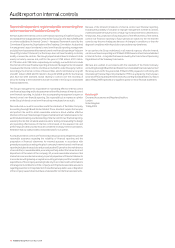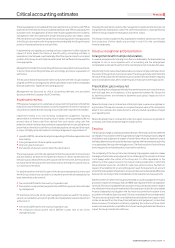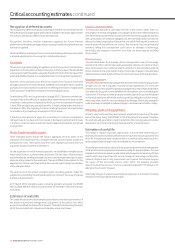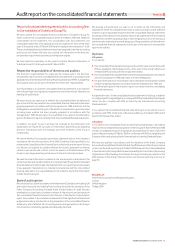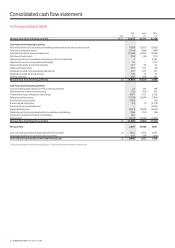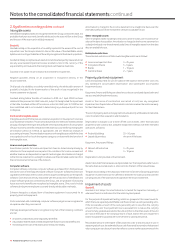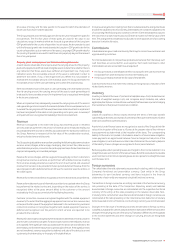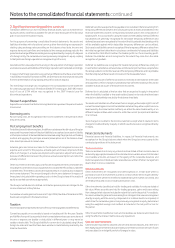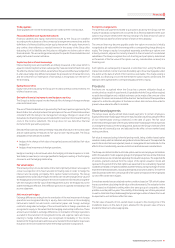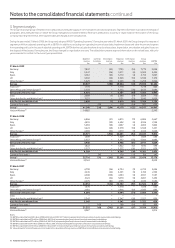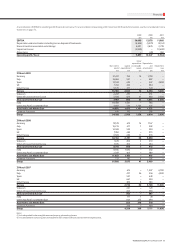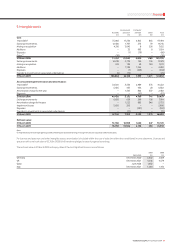Vodafone 2009 Annual Report Download - page 81
Download and view the complete annual report
Please find page 81 of the 2009 Vodafone annual report below. You can navigate through the pages in the report by either clicking on the pages listed below, or by using the keyword search tool below to find specific information within the annual report.
Financials
Vodafone Group Plc Annual Report 2009 79
In revenue arrangements including more than one deliverable, the arrangements are
divided into separate units of accounting. Deliverables are considered separate units
of accounting if the following two conditions are met: (1) the deliverable has value to
the customer on a stand-alone basis and (2) there is evidence of the fair value of the
item. The arrangement consideration is allocated to each separate unit of accounting
based on its relative fair value.
Commissions
Intermediaries are given cash incentives by the Group to connect new customers and
upgrade existing customers.
For intermediaries who do not purchase products and services from the Group, such
cash incentives are accounted for as an expense. Such cash incentives to other
intermediaries are also accounted for as an expense if:
the Group receives an identifiable benefit in exchange for the cash incentive that •
is separable from sales transactions to that intermediary; and
the Group can reliably estimate the fair value of that benefit.•
Cash incentives that do not meet these criteria are recognised as a reduction of the
related device revenue.
Inventory
Inventory is stated at the lower of cost and net realisable value. Cost is determined on
the basis of weighted average costs and comprises direct materials and, where
applicable, direct labour costs and those overheads that have been incurred in bringing
the inventories to their present location and condition.
Leasing
Leases are classified as finance leases whenever the terms of the lease transfer
substantially all the risks and rewards of ownership of the asset to the lessee. All other
leases are classified as operating leases.
Assets held under finance leases are recognised as assets of the Group at their fair
value at the inception of the lease or, if lower, at the present value of the minimum
lease payments as determined at the inception of the lease. The corresponding
liability to the lessor is included in the balance sheet as a finance lease obligation.
Lease payments are apportioned between finance charges and reduction of the
lease obligation so as to achieve a constant rate of interest on the remaining balance
of the liability. Finance charges are recognised in the income statement.
Rentals payable under operating leases are charged to the income statement on a
straight line basis over the term of the relevant lease. Benefits received and receivable
as an incentive to enter into an operating lease are also spread on a straight line basis
over the lease term.
Foreign currencies
The consolidated financial statements are presented in sterling, which is the parent
Company’s functional and presentation currency. Each entity in the Group
determines its own functional currency and items included in the financial
statements of each entity are measured using that functional currency.
Transactions in foreign currencies are initially recorded at the functional currency
rate prevailing at the date of the transaction. Monetary assets and liabilities
denominated in foreign currencies are retranslated into the respective functional
currency of the entity at the rates prevailing on the balance sheet date. Non-
monetary items carried at fair value that are denominated in foreign currencies are
retranslated at the rates prevailing on the initial transaction dates. Non-monetary
items measured in terms of historical cost in a foreign currency are not retranslated.
Changes in the fair value of monetary securities denominated in foreign currency
classified as available for sale are analysed between translation differences and other
changes in t he carrying amount of the secur ity. Translation dif ferences are recognised
in the income statement and other changes in carrying amount are recognised
in equity.
time value of money and the risks specific to the asset for which the estimates of
future cash flows have not been adjusted.
The Group prepares and internally approves formal ten year management plans for
its businesses. The first five years of these plans are used for the value in use
calculations, except in markets which are forecast to grow ahead of the long term
GDP growth rate for the country of operation. In such cases, the ten year plan is used
until the forecast growth rate trends towards the long term GDP growth rate for the
countr y of operation, up to a maximum of ten years. Long range GDP growth rates for
the country of operation are used for cash flows into perpetuity beyond the relevant
five or ten year period.
Property, plant and equipment and finite lived intangible assets
At each balance sheet date, the Group reviews the carrying amounts of its property,
plant and equipment and finite lived intangible assets to determine whether there is
any indication that those assets have suffered an impairment loss. If any such
indication exists, the recoverable amount of the asset is estimated in order to
determine the extent, if any, of the impairment loss. Where it is not possible to
estimate the recoverable amount of an individual asset, the Group estimates the
recoverable amount of the cash-generating unit to which the asset belongs.
If the recoverable amount of an asset or cash-generating unit is estimated to be less
than its carrying amount, the carrying amount of the asset or cash-generating unit
is reduced to its recoverable amount. An impairment loss is recognised immediately
in the income statement.
Where an impairment loss subsequently reverses the carrying amount of the asset or
cash-generating unit is increased to the revised estimate of its recoverable amount , not
to exceed the carrying amount that would have been determined had no impairment
loss been recognised for the asset or cash-generating unit in prior years. A reversal of
an impairment loss is recognised immediately in the income statement.
Revenue
Revenue is recognised to the extent the Group has delivered goods or rendered
services under an agreement, the amount of revenue can be measured reliably and
it is probable that the economic benefits associated with the transaction will flow to
the Group. Revenue is measured at the fair value of the consideration received,
exclusive of sales taxes and discounts.
The Group principally obtains revenue from providing the following telecommunication
services: access charges, airtime usage, messaging, interconnect fees, data services
and information provision, connection fees and equipment sales. Products and services
may be sold separately or in bundled packages.
Revenue for access charges, airtime usage and messaging by contract customers is
recognised as revenue as services are performed, with unbilled revenue resulting
from services already provided accrued at the end of each period and unearned
revenue from services to be provided in future periods deferred. Revenue from the
sale of prepaid credit is deferred until such time as the customer uses the airtime, or
the credit expires.
Revenue from interconnect fees is recognised at the time the services are performed.
Revenue from data services and information provision is recognised when the Group
has performed the related service and, depending on the nature of the service, is
recognised either at the gross amount billed to the customer or the amount
receivable by the Group as commission for facilitating the service.
Customer connection revenue is recognised together with the related equipment
revenue to the extent that the aggregate equipment and connection revenue does
not exceed the fair value of the equipment delivered to the customer. Any customer
connection revenue not recognised together with related equipment revenue is
deferred and recognised over the period in which services are expected to be
provided to the customer.
Revenue for device sales is recognised when the device is delivered to the end customer
and the sale is considered complete. For device sales made to intermediaries, revenue
is recognised if the significant risks associated with the device are transferred to the
intermediary and the intermediary has no general right of return. If the significant risks
are not transferred, revenue recognition is deferred until sale of the device to an end
customer by the intermediary or the expiry of the right of return.



